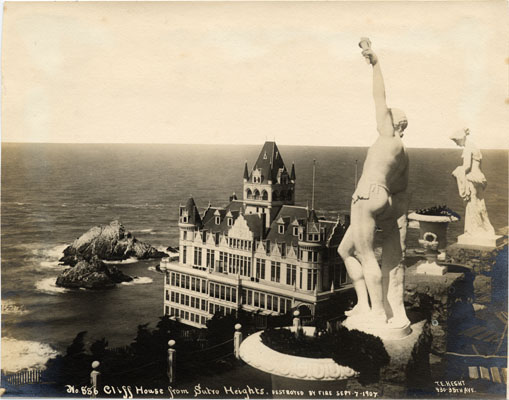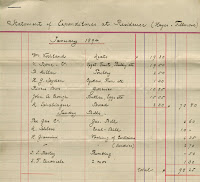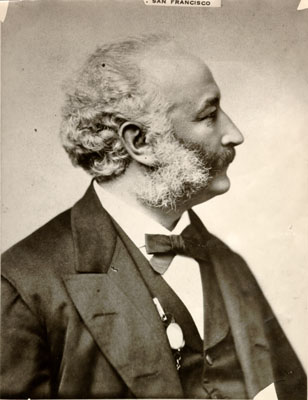 |
| Cliff House from Sutro Heights |
A stately Pleasure-Dome decree,
Where Alph, the sacred river ran
Through caverns measureless to man
Down to a sunless sea.”
The opening lines to Samuel Taylor Coleridge’s poem “Kubla Khan” seem a fitting introduction to Adolph Sutro and his legacy in San Francisco. A sunless sea breaks at the the foot of the fog-cloaked cliffs of Lands End where the Sutro Baths, the Cliff House, and Sutro Heights were built.
Adolph Sutro
|
Adolph Heinrich Joseph Sutro (1830-1898) was an American financier, philanthropist and public official. He was born at Aix-la-Chapelle, Rhenish Prussia on April 29, 1830. Adolph, along with his mother and most of his brothers and sisters, moved to the United States in 1850; he continued on to California the following year.
In 1860, he moved to Nevada during the Comstock silver mining bonanza. Sutro designed and oversaw the construction of a tunnel (known as "Sutro Tunnel") to alleviate ventilation and flooding problems inherent in mining operations at the Comstock Lode. In 1878, when the tunnel was completed and in operation, Sutro sold his interest in it for about $1,000,000 and returned to San Francisco, where he entered the real estate field. In his heyday, Sutro owned almost one-twelfth of the real property in San Francisco, including San Miguel Rancho and the property surrounding Sutro Baths and the Cliff House.
His business interests in California included: Sutro Baths; Sutro Heights; the Reese block; the Cliff House; San Miguel Ranch; Merrie Way and Railroad; and the Napa County Ranch, Arcadia. He improved these properties and opened the grounds surrounding his home at Sutro Heights to the public.
| Beach from Sutro Heights postcard |
Adolph Sutro served as Mayor of San Francisco from 1894 to 1896. He was married to Leah Harris and they had six children: Emma Laura Sutro Merritt, Rose Victoria Sutro Morbio, Charles Walter Sutro, Kate Sutro Nussbaum, Edgar Ernest Sutro and Clara Angelina Sutro de Choiseul. Leah died in 1893; Adolph died on August 8, 1898.
 |
| 1894 Sutro election flyer |
Archival Materials
Sutro's papers did not remain intact after his death. As a result, there are several collections of related material throughout the San Francisco Bay Area and beyond. Together these form a record of Sutro's business and personal life. The Adolph Sutro Papers at the Bancroft Library is the largest single collection, amounting to 23 boxes and 9 cartons. It is estimated that the Bancroft Library holds about half of Sutro's papers. The San Francisco Public Library (SFPL), Stanford University, the California State Library, the California Historical Society, and the Beinecke Library at Yale University all have smaller, complementary collections.
The SFPL materials include: the Adolph Sutro Collection; the Adolph Sutro biography files; the Sutro Baths Architectural Drawings; correspondence to Adolph Sutro from his children and his brothers (held in the Small Manuscripts Collection); photographs documenting the Sutro estate, including Sutro Heights; and various pieces of ephemera from Sutro Baths and other Sutro business interests.
The Adolph Sutro Collection contains bills, payrolls, receipts, cancelled checks and other records for numerous Sutro enterprises and properties, including Cliff House Ranch, Napa County Ranch, Reese Block, San Miguel Ranch, Sutro Baths, Sutro Heights and Sutro Railroad. The most extensive records cover the years 1894 and 1896, when the Cliff House burned down and was rebuilt.
The bills and receipts offer a good example of the household costs for upper class residents of San Francisco. In addition to simply documenting a business transaction, receipts themselves are sometimes beautiful examples of engraving. Moreover, as we can see on the back of this Parisian Dyeing and Cleaning receipt, receipts may depict scenes and buildings that are not otherwise pictured.
Sutro's papers did not remain intact after his death. As a result, there are several collections of related material throughout the San Francisco Bay Area and beyond. Together these form a record of Sutro's business and personal life. The Adolph Sutro Papers at the Bancroft Library is the largest single collection, amounting to 23 boxes and 9 cartons. It is estimated that the Bancroft Library holds about half of Sutro's papers. The San Francisco Public Library (SFPL), Stanford University, the California State Library, the California Historical Society, and the Beinecke Library at Yale University all have smaller, complementary collections.
 |
| Statement of expenses |
The Adolph Sutro Collection contains bills, payrolls, receipts, cancelled checks and other records for numerous Sutro enterprises and properties, including Cliff House Ranch, Napa County Ranch, Reese Block, San Miguel Ranch, Sutro Baths, Sutro Heights and Sutro Railroad. The most extensive records cover the years 1894 and 1896, when the Cliff House burned down and was rebuilt.
 |
| Parisian cleaning receipt |
 |
| Parisian cleaning receipt |
The payrolls offer examples of the numbers of people employed by Sutro during this time period, the work that they did, and the rate of pay for each type of job. The 1873 receipts and disbursements for the Sutro Tunnel are the earliest materials in the collection; these include some payrolls. Some of the receipts for Sutro Heights and the Merrie Way include the purchase of amusements from the 1894 Midwinter Fair, and the cost to dismantle and move those pieces from Golden Gate Park to Sutro Heights.
 |
| Sutro Baths payroll |
Of particular note in the Adolph Sutro Collection are the Sutro Baths programs from March 1896-April 1906. These programs list the entertainment to be presented at the Sutro Baths. The programs were produced weekly for most of the years, and coverage appears to be fairly complete from 1896-1901. Starting in 1902, there are occasionally missing programs, and some months are not covered at all. There is only one program from 1905. The receipts in the Sutro Baths series record payments for performers such as Mr. Williams for his tightrope performances at the Baths in April 1896.
 |
| Sutro Baths program masthead |
The Adolph Sutro Collection and the San Francisco Biography Collection are available at the San Francisco History Center, 6th floor, Main Library. In this post we've touched on some of the SFPL archival resources about Adolph Sutro. We'll continue to explore additional materials in an upcoming blog post: "Adolph Sutro: A Triumph of Life."


Comments
Post a Comment